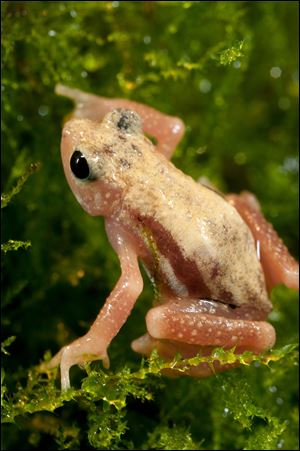
Toads from Toledo zoo released into wild in East Africa
11/1/2012Editor's note: This version corrects the date that the toads were released.

The Kihansi spray toad, a native of Tanzania.
More than 10 years after a handful of tiny Kihansi spray toads arrived at the Toledo Zoo, some 2,500 of the little guys and gals were released this week into the wild of their native Tanzania.
It was a major step in the quest to breed and reintroduce the species that disappeared from the wild in 2004 and was declared extinct in the wild in 2009.
“As of today they are reintroduced into the wild,” a jubilant Jeff Sailer, executive director of the Toledo Zoo, said Wednesday. “It will take some time before the different powers that be around the world officially say they’re back, and there probably always will be a little asterisk by it since there will be some type of human involvement.”
While the toads — 1,000 from the Toledo Zoo, 1,000 from the Bronx Zoo in New York City, and 500 raised in Tanzania — were returned to the very small habitat in which they were discovered in 1996, a system of sprinklers was first installed to recreate the effects of the waterfall in the Kihansi River Gorge. The waterfall had been greatly reduced by the construction of a hydroelectric dam there in 1999.
“The big question now is, ’What will these 2,500 frogs do?’ ” Mr. Sailer said. “Will we go back in a year and there will be 10,000 of them running around all over the place or will there only be a few left?”
The toads let loose on Tuesday have been given identifying marks. The adult toads are small enough to perch on a quarter; their offspring, which are born fully formed, are the size of a large fruit fly.
“The big success would be finding an unmarked frog in the next few months,” Mr. Sailer said. “That would mean not only did reproduction occur, but that the baby was able to grow, develop, and become an adult.”
Disease, which is believed to have been a major contributor to the species’ demise in the first place, is one of the biggest dangers the toads will face.
R. Andrew Odum, the zoo’s herpetology curator, was in Tanzania with the zoo's chief veterinarian, Dr. Chris Hanley. Mr. Sailer said Mr. Odum told him that working on the reintroduction of the species was “the hallmark” of his career.
“The level of collaboration, from the Tanzanian government and the participating zoos to the Tanzanian field biologists and students who shared their knowledge with us, has been nothing short of inspiring,” Mr. Odum said in a statement released by the zoo.
Zoo officials expect to continue releasing more of the Kihansi spray toads into the wild while maintaining “an assurance colony” at the zoo. Mr. Sailer suspects there always will be a home for them at the Toledo Zoo’s Amazing Amphibian exhibit.
“It’s a great education story, and it’s a great opportunity for people here in the community to see what their zoo is doing here and what their zoo is doing worldwide,” he said.
As Cristian Samper, president and chief executive of the Wildlife Conservation Society, which manages the Bronx Zoo, put it, “The reintroduction of the Kihansi spray toad to the Kihansi Gorge in Tanzania is a momentous achievement in conservation. This has been a truly global effort to save a species.”
Contact Jennifer Feehan at: jfeehan@theblade.com or 419-724-6129.